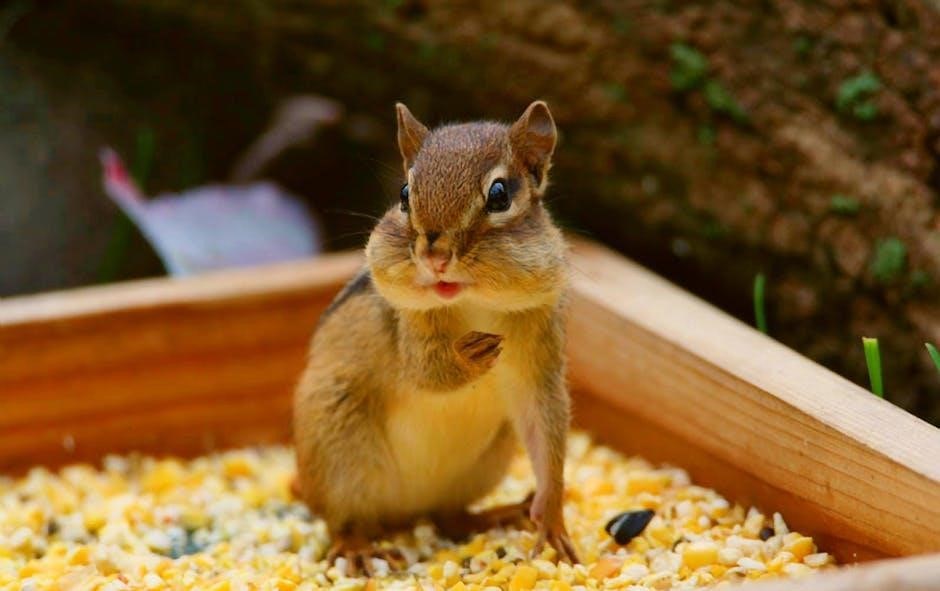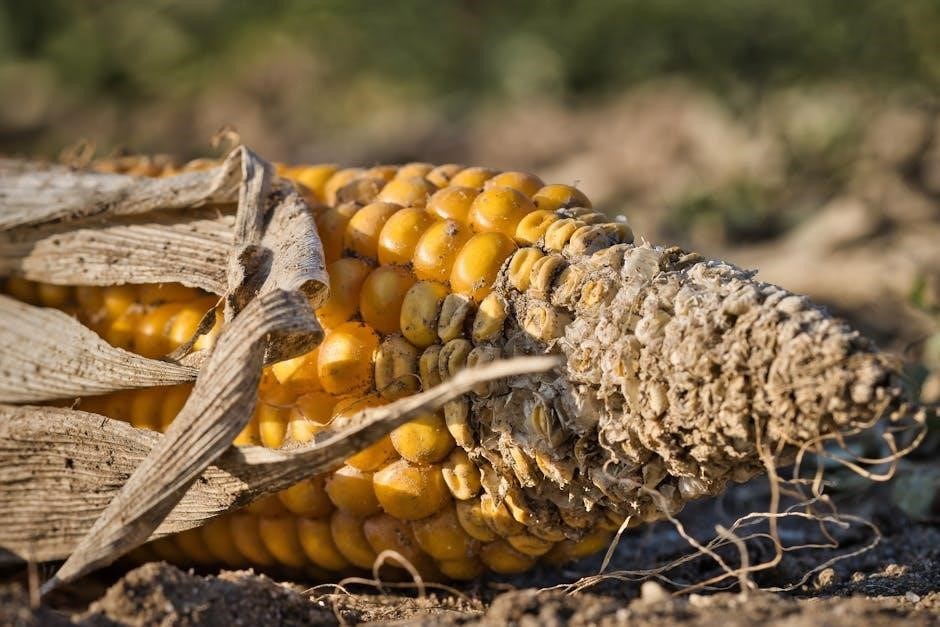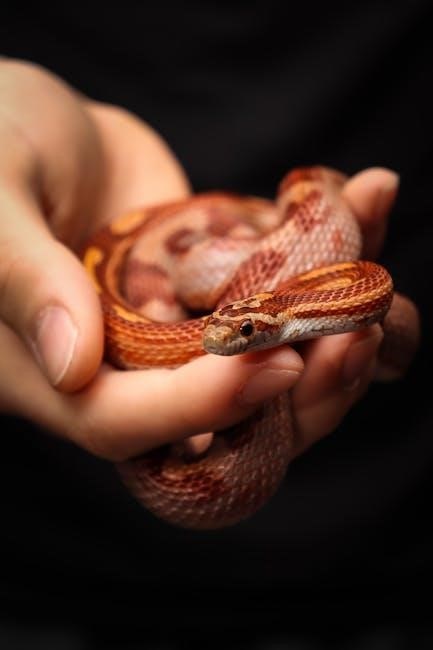Prey Size and Selection for Corn Snakes
Prey size is crucial for corn snakes, ensuring meals are proportionate to their body width. Hatchlings start with pinkies, progressing to larger prey as they grow. Prey should be 1-1.5 times the snake’s widest girth, avoiding oversized items that may cause discomfort. Recommended prey includes mice and rats, while other animals should be avoided. Size selection depends on age, weight, and digestion efficiency, preventing overfeeding and promoting healthy growth.
1.1 Criteria for Selecting Appropriate Prey Size
Prey size must align with the corn snake’s body proportions to ensure safe digestion and prevent discomfort. The ideal prey item should be 1-1.5 times the snake’s widest girth, avoiding oversized prey that may cause regurgitation or impaction. Hatchlings typically start with pinkies, while adults progress to larger mice or rats. The prey’s width should not exceed the snake’s head, and its length should be manageable for smooth swallowing. Proper size selection promotes healthy digestion and growth.
1.2 Prey Size Variation Based on Snake’s Age and Weight
Prey size must be tailored to the corn snake’s age and weight for optimal health. Hatchlings typically start with pinkie mice, while juveniles graduate to fuzzies or small mice. Adults can consume larger mice or rats. The prey should be proportional to the snake’s body weight, roughly 10% of its total weight. Adjusting prey size based on growth ensures proper digestion and prevents overfeeding. Regular monitoring helps match meals to the snake’s developmental stage and energy needs.

Feeding Schedule for Corn Snakes
Corn snakes’ feeding frequency varies by age and growth stage. Hatchlings eat every 5-7 days, juveniles every 7-10 days, and adults every 10-14 days, aligning with their metabolism and activity levels.
2.1 Feeding Frequency by Age Group (Hatchlings, Juveniles, Adults)
Hatchlings should be fed every 5-7 days, starting with pinkies, to support rapid growth. Juveniles require feeding every 7-10 days, gradually increasing prey size as they grow. Adults, with slower metabolism, are fed every 10-14 days. This schedule aligns with their digestion speed and energy needs, ensuring proper growth and preventing overfeeding. Monitoring the snake’s weight and activity helps adjust the frequency for optimal health.
2.2 Factors Influencing Feeding Frequency (Growth Rate, Activity Level)
Feeding frequency for corn snakes is influenced by growth rate and activity level. Young, fast-growing snakes require more frequent meals, while slower-growing individuals may need less. Active snakes with higher energy expenditure should be fed more often, whereas less active ones may need reduced feeding. Monitoring these factors helps tailor the feeding schedule to the snake’s needs, ensuring optimal growth and preventing overfeeding or malnutrition. Adjustments should be made based on individual observations.
Types of Prey for Corn Snakes
Corn snakes primarily feed on mice and rats, with occasional feeding on gerbils or hamsters. Avoid wild prey, as it can pose health risks to the snake.
3.1 Recommended Prey Items (Mice, Rats, etc.)
Corn snakes thrive on a diet of mice and rats, which provide essential nutrients. Hatchlings typically start with pinkie mice, while juveniles and adults can eat fuzzies or small rats. Prey should be 1-1.5 times the snake’s body width to ensure easy digestion. Gerbils or hamsters are occasional alternatives but should not replace rodents. Avoid wild prey due to potential health risks. Frozen-thawed prey is recommended for safety and convenience, promoting a balanced and nutritious diet for your corn snake.
3.2 Avoiding Inappropriate or Dangerous Prey
Corn snakes should never be fed wild prey, as it may carry diseases or parasites. Avoid live prey, as it can injure the snake. Prey with sharp teeth or spines should be avoided to prevent internal harm. Gerbils or hamsters are not ideal due to their defensive nature. Stick to safe, frozen-thawed mice or rats to ensure a risk-free feeding experience. Avoiding inappropriate prey ensures the snake’s health and safety, promoting a trouble-free feeding process.

Feeding Techniques for Corn Snakes
Use a feeding tub or secure enclosure to minimize stress. Offer prey in the dark, as corn snakes prefer hunting in low-light conditions. Gently place the prey item near the snake, allowing it to strike naturally. Avoid forcing food into the snake’s mouth. Ensure the environment is calm and free from disturbances to encourage a smooth feeding process.
4.1 Best Practices for Offering Prey
Offer prey in a secure, stress-free environment, such as a feeding tub, to encourage natural hunting behavior. Place the prey item near the snake, allowing it to strike independently. Avoid force-feeding, as this can cause stress or injury. Ensure the prey is fresh and appropriately sized for the snake’s girth. Create a calm atmosphere by minimizing disturbances during feeding. This method promotes healthy digestion and prevents food spoilage, ensuring a positive feeding experience for your corn snake.
4.2 Using Feeding Tubs or Enclosures
Feeding tubs or enclosures are excellent for minimizing stress and ensuring a clean feeding process. Place the prey item inside the tub, allowing the snake to hunt naturally. Covering the tub can help the snake feel secure, as corn snakes often prefer to eat in the dark. After feeding, return the snake to its vivarium to digest. This method prevents food spoilage and reduces the risk of contamination, promoting a hygienic feeding environment for your corn snake.
Common Feeding Challenges and Solutions
Recognize feeding refusal by observing lack of interest in prey. Prevent overfeeding by monitoring digestion and adjusting portion sizes. Ensure a stress-free environment for optimal feeding.
5.1 Recognizing and Addressing Feeding Refusal
Feeding refusal in corn snakes can stem from stress, improper environmental conditions, or health issues. Signs include ignoring prey or striking without consuming it. Ensure proper temperature, humidity, and hiding places to reduce stress. Offer prey in a secure feeding tub to encourage eating. If refusal persists, consult a veterinarian to rule out underlying health problems and adjust feeding strategies to stimulate appetite and ensure the snake’s well-being.

5.2 Preventing Overfeeding and Obesity
Overfeeding can lead to obesity in corn snakes, causing health issues like reduced mobility and organ strain. Monitor for bulging scales and lethargy as signs. Maintain a feeding schedule based on age and size, offering prey no larger than 1.5 times the snake’s girth. Avoid feeding during shedding or illness. Use a feeding tub to prevent food seeking behavior and ensure portion control, ensuring meals are balanced and appropriate for the snake’s needs and growth stage.
Monitoring and Adjusting the Feeding Plan
Regularly monitor your corn snake’s growth, adjusting prey size and feeding frequency as needed. Look for signs of proper digestion and weight, ensuring a balanced diet.
6.1 Signs of a Well-Fed Snake
A well-fed corn snake exhibits a rounded, robust appearance with smooth, shiny scales. The snake should actively seek prey and display a strong feeding response. Ensure the prey size is proportionate to the snake’s girth, promoting proper digestion. Avoid overfeeding by monitoring for visible fat reserves or lethargy. A healthy snake sheds skin effortlessly and maintains steady growth. Regularly assess weight and overall condition to adjust feeding plans accordingly for optimal health.
6.2 Adjustments Based on Snake’s Growth and Health
Monitor your corn snake’s growth and health to adjust feeding plans. Increase prey size as the snake grows, ensuring items remain proportionate to its girth. For underweight snakes, consider more frequent meals or slightly larger prey; If the snake appears overweight, reduce feeding frequency. Watch for signs like dull scales or lethargy, which may indicate overfeeding. Adjustments should aim to maintain a balanced weight and promote steady, healthy growth without risking obesity or digestion issues.
Recognizing When Not to Feed
Avoid feeding corn snakes during shedding, illness, or digestion issues. Signs like bulging scales or lethargy indicate overfeeding. Refrain from feeding until the snake recovers or sheds.
7.1 Signs of Overfeeding or Poor Digestion
Recognize overfeeding through visible signs like bulging scales or a noticeably rounded midsection. Poor digestion may manifest as regurgitation or lethargy. Monitor for labored breathing or lack of interest in movement. If a corn snake shows these symptoms, it’s crucial to withhold feeding until digestion improves. Additionally, observe the time it takes for the snake to pass a meal; prolonged digestion can indicate overfeeding. Adjust portion sizes and feeding frequency to prevent these issues.
7.2 Feeding During Shedding or Illness
Feeding corn snakes during shedding or illness is generally not recommended. Shedding requires energy, and feeding can disrupt this natural process. Similarly, ill snakes may lose appetite or have digestive issues. Wait until shedding is complete and the snake is active again. For sick snakes, consult a veterinarian before resuming feeding to ensure recovery. Avoid feeding during these times to prevent complications and allow the snake to heal properly.
Frequently Asked Questions About Corn Snake Feeding
Common questions include feeding frequency, prey size, and recognizing feeding refusal. Hatchlings are fed every 5-7 days, while adults eat every 10-14 days. Prey size should match the snake’s girth, and refusing food may indicate stress or illness. Always ensure proper feeding practices for optimal health. Consult guides for detailed answers to these FAQs.

8.1 How Often Should I Feed My Corn Snake?
Feeding frequency for corn snakes varies by age and size. Hatchlings should be fed every 5-7 days, while juveniles require feeding every 7-10 days. Adult corn snakes typically eat every 10-14 days. The schedule ensures proper digestion and prevents overfeeding. Growth rate and activity level also influence frequency. Monitor your snake’s condition and adjust feeding times accordingly to maintain optimal health and avoid obesity. A balanced feeding plan supports their natural metabolism and overall well-being.

8.2 What Prey Size is Ideal for My Snake?
The ideal prey size for a corn snake is 1-1.5 times the snake’s widest girth. Hatchlings start with pinkies, juveniles progress to fuzzies, and adults eat larger mice or rats. Prey should never be wider than the snake’s head to ensure safe swallowing. Measure your snake’s mid-body girth to gauge prey size accurately. Avoid oversized prey to prevent discomfort or health issues. Proper sizing promotes efficient digestion and supports overall health.
